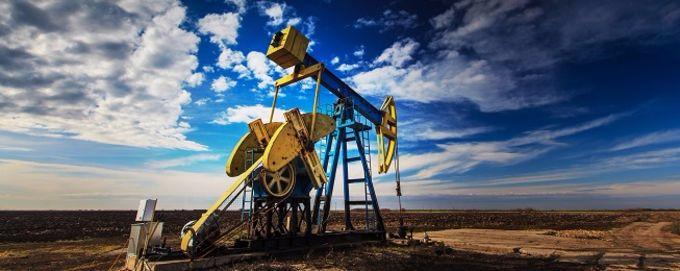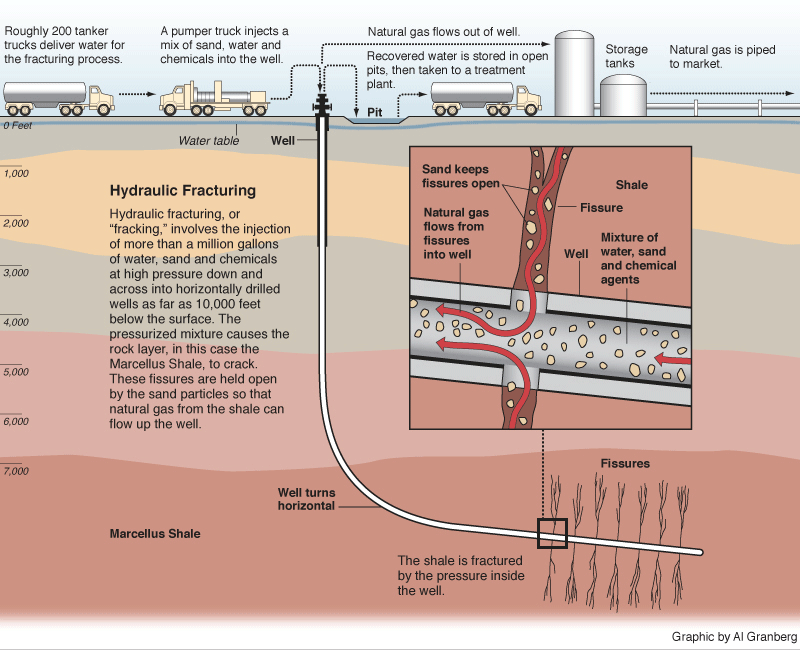
Fracturing a Better Future
What is Hydraulic Fracturing?
Hydraulic fracturing involves the process of injecting water into a well at extremely high pressures that will cause fractures of the reservoir rock in order to allow better flow of natural gas and oil. The well is drilled into the Earth at various depths and lined with concrete or metal in order to create a free-flowing opening, or “well”, for gas and/or oil to erupt to the surface in specific targeted zones. Depending on the type of rock layers or depth of the well reserves, the well will eventually tilt horizontally thousands of feet below the surface. Water and other additives are used in order to aid in the extraction of these fuels and are usually brought back to the surface with the fuel extracted. Chemicals are added to the water to reduce friction, and there are other foaming agents that aid in the breakup of porous rocks. There is also a mixture of sand that holds the openings of the porous rocks open to further ease the flow [2].
This particular method tends to use thousands of gallons of water per well, but it is the most commonly used technique across the manufacturing sector. Large portions of the injected water returns to the surface with the flow of oil and natural gas and has to be stored in above ground “pits.” Some of the water is taken to treatment plants for reprocessing while the remainder is injected back into the ground in wastewater disposal wells. In some cases, the chemicals can leak out of a well through holes in the lining, contaminating aquifers or other water supplies. In other cases, pits can also leak and dump thousands of gallons of highly toxic material into lakes, streams, rivers and other bodies of water [3, 4].

Hydraulic Fracturing [4]
Why is this method the most commonly used?
As the cost of water is next to nothing, companies have little incentive to switch to another agent like Liquefied Propane Gas or other waterless fracturing methods that could be more costly. Waterless fracturing methods vastly decrease or eliminate the need for any water at all, but due to the cost of these materials there are very few companies readily adopting this method. Furthermore, hydraulic fracturing is a proven method that has been around since the early 1950s, but the processes really began hitting their strides in the early 1990s when the usage of horizontal drilling methods emerged that have allowed the extraction large sums of extra fuel from old well fractures.
Hydraulic fracturing has been the extent of tons of research and improvements since its inception, and the methods can clearly work in improving oil and natural gas flow if done correctly. Studies have shown that coaxing a well through fracturing releases more gas at a faster rate than a well that is not fractured. This means a company can get more bang for their buck at a faster rate as opposed to drilling without fracturing [4]. The largest issue with hydraulic fracturing methods is the amount of water usage per well and the different types of disposal methods for water that has been reclaimed from the well. Considering that there are thousands of active wells in the United States alone, the estimated usage of water per year is in the billions of gallons. In the past 15 years, the number of wells has exploded and as a result has allowed the United States to become a world leader in the production of hydrocarbons like natural gas. With all the production comes a large increase in the amount of water usage, so moving towards a non-hydraulic form of fracturing will decrease many of the issues highlighted in the following sections [5].